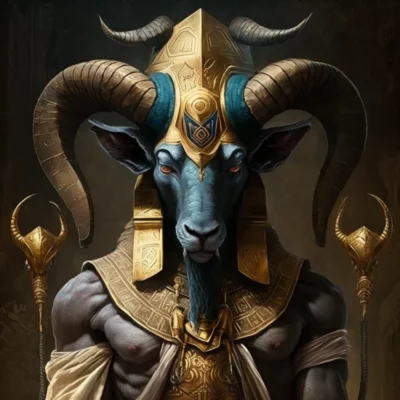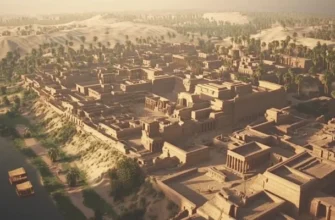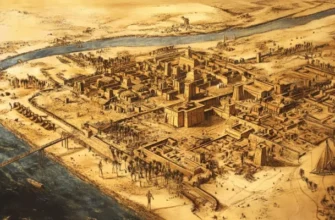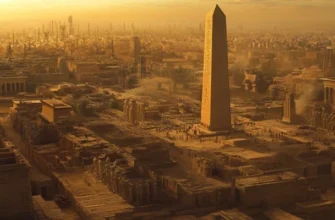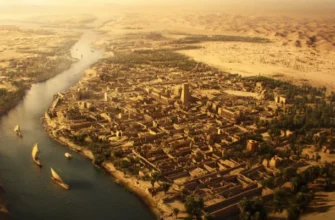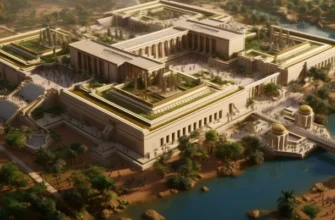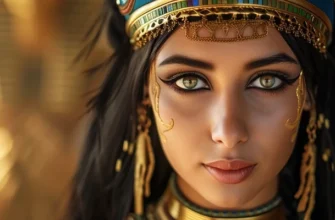Khnum is one of the most important gods in Egyptian mythology. He was associated with fertility and water, as well as being the divine potter and creator of humanity. In this article, we will take a closer look at the characteristics, symbolism, and functions of the god Khnum, as well as his role in Egyptian mythology and culture.
Khnum was depicted as a man with a ram’s head, or as a ram. His symbolism also often included aquatic plants and animals, which linked him to water and the plant world. Khnum was one of the oldest gods in Egyptian mythology, and he had great power over water, which was important for the fertility of the land and life in Egypt.
Khnum symbolized creation and destruction, fertility and rebirth. It was associated with pottery because it created human bodies on a potter’s wheel of marshy clay on the banks of the Nile. This symbolized the creation of life from nothing. In addition, Khnum was also associated with destruction because he could flood the earth if he was frightened or offended.
Khnum played an important role in Egyptian mythology and religion. He was the god of pottery and the creation of life.
Khnum symbolized creation and destruction, fertility and rebirth. He was a symbol of life because his created bodies were spiritual elements that were reborn in the bodies of the dead. Khnum was also associated with destruction, as he could flood the earth if he was frightened or offended. His symbols, the ram and water plants, were also associated with fertility and water.
- Who is Khnum?
- Origin and history of the god Khnum
- Legends and myths about Khnum
- Khnum in Egyptian culture
- The cult of Khnum in Egypt
- Characteristics of Khnum
- Physical description of Khnum
- Functions and symbolism
- Symbols and attributes of the god Khnum
- Egyptian economy.
- Relationship of Khnum to other deities of the Egyptian religion
- Khnum’s influence on modernity
- Conclusions.
Who is Khnum?
Khnum is a god in Egyptian mythology who was associated with pottery, water, fertility, and the creation of life. He was one of the most important gods of the Egyptian religion, and his cult was widespread in various regions of Ancient Egypt.
Images of the god Khnum can be found on many walls of temples and pyramids. He was depicted as a man with a ram’s head or as a ram with water plants on his head. He had an important role in the life of the Egyptians, as he played the function of the creator of life and the destroyer.
Khnum was associated with pottery, as he created human bodies on a potter’s wheel of marsh clay on the banks of the Nile River. He was also associated with water because he lived on the banks of the river and had power over water. Khnum also symbolized rebirth and fertility, as his created bodies were spiritual elements that were reborn in the bodies of the dead.
Henna also played an important role in Egyptian religious rites, especially those related to birth and rebirth. He played the function of a protector against disaster and the evil eye. Khnum was associated with many other gods, including Amun and Ra.
In general, Khnum was a very important god in Egyptian mythology, as he symbolized creation and destruction, fertility and rebirth, and played an important role in the culture and religion of the Egyptians. Henna was a part of many legends and myths in which it played a key role. One of the most famous stories related to the god Khnum is his participation in the creation of mankind.
According to the legend, Khnum created human bodies from muddy clay on a potter’s wheel and then handed them over to the goddess Isis, who gave them souls. This story symbolized rebirth and rebirth, as the people who were created by Khnum were reborn in their souls after death.
Khnum was also associated with the cult of water and the Nile River, as he lived on the banks of the river and had power over water. The Egyptians believed that he controlled the water level in the river and provided enough water for agriculture and life.
The Temple of Khnum was located in Esna, a city in southwestern Egypt. This temple was one of the most important places of worship of the god Khnum and a place of pilgrimage.
All these facts show how important the god Khnum was in the culture and religion of ancient Egypt. His role in creating and reviving life, controlling water, and protecting against disaster made him one of the most revered gods in Egyptian mythology.
Origin and history of the god Khnum
Khnum was one of the oldest gods in Egyptian mythology. His cult was widespread throughout Ancient Egypt from the time of the Ancient Kingdom (ca. 2686-2181 BC). The name “Khnum” literally translates as “molder” or “designer”.
Khnum was represented as a deity with a human head and a goat’s body. He also had bull horns, which symbolized his mystical power. Khnum was often depicted with a potter’s wheel on which he created human bodies and various creatures.
Khnum was associated with the goddess Nehebkau, the god Ra, and other deities. He was also often depicted with two other gods, Amun and Ra. This triad was very important in Egyptian mythology and was associated with the cult of the sun and the creation of the world.
Over time, belief in Khnum changed and evolved. Still, he remained an important symbol of creativity and rebirth in Egyptian mythology. His cult continued to exist until the end of the Ancient Egyptian period, that is, until the conquest of the country by the Romans in 30 BC.
Today, Khnum remains one of the most interesting and mysterious gods of Egyptian mythology, which still arouses admiration and interest among scholars and history buffs.
The role of Khnum in Egyptian mythology
Khnum played an important role in Egyptian mythology and religion. He was the god of creativity and rebirth, as well as the god of the Nile waters and pottery.
One of Khnum’s main functions was to create human bodies. He created bodies for souls, which were then reborn in life after death. This function of the god Khnum was connected with the belief in the reincarnation of the soul after death, which was very important in Egyptian religion.
Khnum also played an important role in the production of water, which was vital for agriculture in ancient Egypt. It was connected to the Nile, the river that provided water for irrigation of arable land and agriculture. Khnum also symbolized the changing of the seasons, when the Nile flooded the land and created conditions for growing different crops.
In addition, Khnum was the god of pottery. He created various creatures and things, including pitchers, bowls, and figurines. His works were a symbol of his creativity and ingenuity.
Over time, Khnum became associated with the cult of the sun, which was very important in Egyptian mythology. He was often depicted together with the gods Amun and Ra as part of a triad that symbolized the sun, sky, and earth.
In general, Khnum played an important role in Egyptian mythology and religion as a god of creativity, rebirth, and pottery. His cult was widespread throughout Ancient Egypt, and he was revered as one of the most important gods.
Khnum also played an important role in various myths and legends. In one of these myths, Khnum creates a man on a potter’s wheel from clay from the Nile. In another myth, he helps the goddess Isis find the body of her husband Osiris, which had been cut into several pieces by his brother Seth.
Khnum also had his own shrines and temples, which were located throughout Ancient Egypt. One such temple, the Temple of Khnum, was built in Elephantine in southeastern Egypt. This temple was dedicated to the cult of the god Khnum and was the place where various religious ceremonies and rites were held.
Images of Khnum were very common in Egyptian art. He was depicted as a deity with the head of a sheep, which had round horns that symbolized rebirth and strength. His body was depicted as a human being or as a man with sheep arms.
In general, Khnum was an important god in Egyptian mythology and religion. He played a role in the creation and rebirth of life, as well as in the production of pottery. His cult was very widespread throughout Ancient Egypt, and images of Khnum were popular in Egyptian art.
Legends and myths about Khnum
In Egyptian mythology, the god Khnum was associated with the creation of the world, rebirth, and the Nile River. There are several legends and myths related to this deity.
One of the most famous legends about Khnum is related to his role in the creation of man. According to this myth, Khnum creates the first human on a potter’s wheel of clay from the Nile. He created man’s body and soul, and sent him out into the world.
Khnum was also associated with the creation of animals. According to one of the legends, he created every animal in the world on his potter’s wheel, adding something special to each of them that made them unique.
There is also a myth about how Hnum helped the goddess Isis find the body of her husband Osiris, which had been cut into several pieces by his brother Seth. Khnum used his skill in pottery to restore Osiris’ body and bring it back to life.
Khnum was also associated with the Nile River, which was very important to the Egyptians. According to one of the legends, he was the creator of the Nile, which provided irrigation for sowing and food for people and animals.
It is known that Khnum was revered in various cities of Egypt, such as Elephantine, Esna, and Philae. In these cities, temples were built that were dedicated to the cult of the god Khnum and were the site of various religious rites and celebrations.
Khnum was also associated with the sun god Ra, whom he helped to be reborn every day. According to one legend, Ra traveled through the underworld every evening, where his body was restored and rejuvenated by the magical knowledge of Khnum.
In addition, Khnum was associated with health and healing. He was often depicted with a pot that he filled with medicinal water from the Nile River. It is believed that this water had healing properties and helped people recover from various diseases.
One of the most famous celebrations associated with the cult of Khnum was the Water Festival, which was held annually in the city of Esna. During this festival, a large number of people gathered at the temple of the god Khnum, where they received healing water from the Nile, and religious ceremonies and rites were performed.
All these myths and legends about Khnum reflected the importance of this deity in Egyptian mythology. Khnum was one of the most important gods who played an important role in creating the world and maintaining various aspects of life in Egypt.
Khnum in Egyptian culture
Khnum was revered in Egypt as an important god who played a role in many aspects of culture and daily life.
One of the most famous places where Khnum was worshipped was the city of Esna, where one of the largest temples of Khnum in Egypt was located. This temple was founded in the Middle Kingdom and rebuilt in the New Kingdom. Great celebrations and rituals were held in this temple in honor of the god Khnum, including the festival of water.
Khnum was also honored in other cities in Egypt, such as Abu Gorab and Edfu. Temples of Khnum were built in these cities, where religious rites and ceremonies were held.
In the art of Egypt, Khnum was often depicted on the walls of temples and pyramids, on tombs and in other religious buildings. He was depicted as a deity with a ram’s head or as a ram standing on its hind legs with its front legs raised. Khnum often held a pot of water or a clay mold, into which he sculpted the shape of a human being on a potter’s wheel.
Khnum also played an important role in various magical and healing rites. For example, it is believed that the image of Khnum on a tomb helped the soul of the deceased to pass to the afterlife. It is also believed that Khnum helped in the treatment of various diseases, in particular, with the help of water from the Nile River, which he purified and charged with healing energy.
The cult of Khnum in Egypt
The cult of Khnum was one of the oldest cults in Egypt and was associated with the cult of the Nile and agriculture. Khnum was a god who was depicted with a ram’s head and sometimes with a human body and a ram’s head. He was considered the god of excessive flow and the keeper of the Nile.
Khnum was also the god of ceramics and the creation of human life. He was associated with the formation of children in the womb and the creation of human souls. Khnum was also associated with the creation of various things, including pots and vases.
In Egypt, the cult of Khnum spread mainly in the land of Elephantine on the Nile River. His temple was located on an island that was connected to the shore by bridges and crossings. This temple was a very important center of pilgrimage for people seeking blessings from the god Khnum.
The cult of Khnum was important to Egyptian mythology and religion, and its influence can be seen in many aspects of Egyptian culture, such as art, literature, and architecture.
In Egyptian art and architecture, Khnum was depicted in various forms and iconography. He was depicted with a ram’s head and a powerful body, as well as with carpentry tools in his hands, symbolizing his role as a creator god.
One of the most famous temples of Khnum is located on the island of Elephantine on the Nile River. This temple was built during the Middle Kingdom and was of great importance to the cult of Khnum. The temple housed a holy statue of Khnum, as well as other religious objects. The temple was decorated with numerous scenes from the life of the god Khnum and other gods of Egyptian mythology.
Also, images of Khnum can be found on a large number of different religious objects, such as sarcophagi, statues, and reliefs. He was also depicted on coins dating back to the Ptolemaic era.
In addition, Khnum was of great importance in ceramics and carpentry, and his name was often used in stamps on products made from these materials. In the art of Egypt, Khnum also played an important role in the symbolism and identification of the creator gods, who were depicted with carpentry tools in their hands.
Characteristics of Khnum
Khnum is a god who had a variety of characteristics and properties in Egyptian mythology. Here are some of the most characteristic features and properties of Khnum:
God of creation: Khnum was known as the god who created the world and humanity. He was considered a creator god who, according to legend, bought clay from the Nile River from which he created humans and animals.
The god of crafts: Khnum was also associated with crafts, particularly ceramics and carpentry. He was considered a god of craftsmen who provided people with the knowledge and skills needed to make a variety of items.
God of fertility: Khnum is also known for his ability to ensure fertility and fecundity in animals and humans. He was associated with the creation and protection of water sources, which ensured the fertility of the land and the development of various forms of life.
The god of the otherworldly guide: Khnum was also the god who guided the souls of the dead to the afterlife. He was considered the guide of souls crossing the Nile River on their way to the afterlife.
Symbolism: Khnum was depicted with a ram’s head and a powerful body, symbolizing his power over animals and the earth. His carpentry tools are also characteristic elements of the god’s symbolism.
Physical description of Khnum
Khnum is a god of Egyptian mythology who is usually depicted with the head of a ram and the body of a man. Here are some characteristics of the physical description of Khnum:
Ram’s head: Khnum is depicted with a ram’s head, symbolizing his power over animals and fertility. The ram’s head has drooping ears, a strong horn on the forehead, and a sharp muzzle.
Face: The hnum has an elongated face with a high forehead and raised eyebrows. Its eyes are usually depicted as large, rounded and expressive.
Body: The lower part of the Hnum’s body is depicted as that of a man, symbolizing his artisanal dexterity and skill. He may have a muscular body with arched shoulders, or a thin body with a high waist and wide hips.
Clothing: A Khnum may have different clothing in images, depending on his function and context. His clothing may consist of a variety of layers, from a bib and skirt to an embroidered shirt and a feathered cloak.
Tools: Khnum is often depicted with various tools that symbolize his ability to create and repair things. Most often in the images he is holding a carpenter’s cutter or a ceramic pot.
In general, the depiction of Khnum can vary depending on the context and function, but his ram’s head is his most recognizable feature.
Representations of Hnum in literature and other sources
Khnum is one of the most widespread gods of Egyptian mythology, and he is mentioned in many literary works of the time. For example, in the Book of the Dead, a collection of texts that accompanied mummies on their journey after death, Khnum is described as a god who helps the dead turn into gods. He was also considered the god of fertility and the protector of artisans who specialized in creating pottery and other crafts.
In many other sources, Khnum is mentioned as the creator of the world and people. He is known for his ability to create things out of clay and pottery, and he is often depicted as a master craftsman or ceramicist. In the Greek poet Hesiod’s Theogony, Hnum is compared to the industrial gods Hephaestus and Hephaestus, who were also considered master craftsmen.
In addition, Hnum was a popular subject in the art of the time, and he was depicted on the walls of temples, in various murals and reliefs. He was usually depicted as a man with a ram’s head holding a variety of tools such as cutters and pots. Such depictions of Khnum were popular throughout Egyptian history and reflected his important role in the culture and religion of the time.
Functions and symbolism
The god Khnum is an important figure in Egyptian mythology and religion, and has a variety of functions and aspects of his divine persona. Some of the main functions attributed to Khnum include the following:
Creator of the world: Khnum was considered the creator of the world in some versions of Egyptian mythology. He created the world out of clay on a potter’s wheel, and it was believed that he created the first humans out of clay.
The god of water and rivers: Khnum was also the god of water and rivers, and his name means “the one who flows”. He was considered the protector of the water world, and helped in controlling the flow of water on the Nile.
God of fertility: Khnum was associated with the earth’s ability to produce fruit and fertility. He was considered the patron saint of agriculture, particularly farming and crafts.
Protector of animals: Henom was associated with animals, particularly rams and goats, and was considered their protector. His cult was often associated with that of other gods such as Amun and Ra.
Protector of souls: Khnum helped deceased souls to be reborn in the other world, and was considered the patron saint of those who died in a peaceful state. He also assisted in resurrection and rebirth.
In his religion, Khnum was an important figure and had a large cult in Egypt.
Symbols and attributes of the god Khnum
The god Khnum had his own symbols and attributes that were often used in Egyptian art and religion to identify him. Some of these include the following:
A hat: Khnum was often depicted with a hat made of green cloth, which symbolized fertility and agriculture.
Clay: Khnum was associated with clay, which he used to create the world and the first humans. Clay also symbolized fertility and fecundity.
Potter’s wheel: Khnum was often depicted with a potter’s wheel on which he created the world and people from clay. This symbolized his role as creator.
Ram: The ram was an attribute of Khnum because the god was associated with these animals as their patron. The ram also symbolized virility and strength.
Crown: Khnum was often depicted with a crown that consisted of three parts: an upper part with ram’s horns, a middle part with two feathers, and a lower part of a golden body. This crown symbolized his role as the god of water and rivers.
Statues: In many temples dedicated to Khnum, he was depicted as a statue with a ram or ram’s head. Such statues were intended for worship and sacrifice.
The role of Khnum in Egyptian religion
Khnum was a very important god in Egyptian religion because he was associated with many aspects of Egyptian life. Here are some of the roles he played:
Creator: Khnum was associated with the creation of the world and the first humans. He was considered the god of clay and pottery, and he used the potter’s wheel to create human bodies and souls.
The god of water: Khnum was associated with water and rivers as he was considered the patron saint of water. He controlled the water level in the Nile and was associated with the custom of passing from one life stage to another.
The patron saint of the pharaoh: Khnum was associated with the pharaohs and was considered their patron saint. He was especially important to the pharaohs, who associated their power with his authority over water and earth.
The deity of birth: Khnum was also associated with the birth celebration as he was considered the god who ensured the health and well-being of the mother and child during birth.
The god responsible for the life cycle: Khnum also played an important role in the life cycle. He was associated with the birth, growth, and spoilage of plants, which played an important role in the
Egyptian economy.
Hence, Hnum played a variety of roles in Egyptian religion and culture.
Religious rituals and deification of the god Khnum
Khnum was deified and honored in a variety of religious rites and celebrations in Egypt. Here are some examples of religious rituals and adoration related to the god Khnum:
– The Feast of Khnum: Egyptians celebrated the festival of Khnum in the middle of summer. It was a holiday that symbolized the birth of Khnum. At the festival, people made sacrifices in his name, made images of the god, danced and sang.
Religious rituals: The god Khnum was associated with many religious rites, including the rite of ablution, which was performed on the banks of the Nile. People believed that Khnum helped cleanse their bodies and souls of sins and impurities.
Local temples: Temples of the god Khnum were located in various places in Egypt, including Esna and Elephantine. People from all over Egypt traveled to these temples to pray and offer sacrifices to the god Khnum.
Images of the god: The god Khnum was depicted as a man with a ram’s head and two large horns, or as a man with a ram’s head and pottery tools. Also, in various places in Egypt, you can find images of Khnum on walls and works of art.
Thus, Khnum was an important god in Egyptian religion, and his images and symbols were found everywhere in Egypt.
Relationship of Khnum to other deities of the Egyptian religion
Khnum is one of the most prominent deities of ancient Egypt, depicted as a god with a ram’s head and a normal human figure. He was associated with the Nile River, which was the lifeblood of the people of Egypt, and he played a key role in the creation of human bodies in the womb.
Khnum also often interacted with other deities of ancient Egypt. Below are some of the most important deities with whom he had a relationship:
Ra – Khnum was associated with Ra, the sun god, and was often depicted alongside him.
Isis – Isis was the goddess of motherhood and protection, and she was associated with Khnum, who played a key role in the creation of life.
Osiris – Osiris was the god of the afterlife and rebirth, and he was often associated with Khnum because of their shared connection to creation and life.
Set – Set was the god of chaos and evil, and he sometimes interacted with Khnum as his adversary.
Isis – Isis was the goddess of magic and wisdom, and she interacted with Khnum as his counselor and helper.
Hnum-Hepri – Hnum-Hepri was the union of Hnum and the sun god Hepri, and he represented the power of creation and rebirth.
Ammut – Ammut was the god of the underworld, and he sometimes interacted with Khnum as his enemy.
In general, Khnum had a large number of correlations with other deities who were associated with different aspects of life and nature. For example:
Anubis – Anubis was the god of death and mummification, and he interacted with Khnum as part of the process of processing and preparing the body for funeral.
Thoth – Thoth was the god of wisdom and knowledge, and he sometimes interacted with Khnum as his counselor and teacher.
Ma’at – Ma’at was the goddess of order and truth, and she interacted with Khnum as his patron and symbol of harmony.
Sekhmet – Sekhmet was the goddess of war and protection, and she sometimes interacted with Khnum as his ally and protector.
Nefertum – Nefertum was the god of beauty and nature, and he was associated with Khnum as his collaborator and helper in creating new life.
Bastet – Bastet was the goddess of jewels and harmony, and she sometimes interacted with Khnum as his patroness and symbol of peaceful coexistence.
Khnum’s interaction with other deities reflected the complex and multifaceted religious tradition of ancient Egypt. At the same time, it also reflected important aspects of the culture and life of this people, such as creation, life, death, and rebirth.
Khnum’s influence on modernity
Khnum, as a deity of ancient Egypt, has no direct influence on modern times. However, researching and studying the culture, mythology, and religion of ancient Egypt, to which Khnum belonged, can help us better understand the past and our roots, and thus be an important part of our cultural heritage.
In addition, Khnum, as the god of creation, rebirth, and craft, can reflect important meanings for our modern world. For example, his significance in the creation of new life may remind us of the importance of protecting and preserving nature and biodiversity. Also, its significance in craft can remind us of the importance of preserving traditional crafts and arts in our modern world.
So, while Hnum has no direct impact on modernity, learning about its culture and religion can be helpful in better understanding our heritage and our values.
Cultural references and applications of Khnum in the modern world
As the god of creation and craft, Khnum can find its application in the modern world as a symbol of creativity and working skill. His image can be used as a decorative element in architecture, art, design, and other fields. In addition, its symbolism can be used in emblems, logos, and branding that conveys ideas of creativity and craftsmanship.
In the modern world, one can also observe the influence of Khnum on various artistic and cultural projects that reflect his significance as the god of creation and craft. For example, in movies, television series, and video games, one can see images of Khnum and his cult attributes.
Western tourists visiting Egypt may also encounter images of Khnum in tourist attractions and museums that showcase the rich cultural heritage of this country.
In some cases, the symbolism of Khnum can be used as part of local culture and traditions. For example, in some modern local crafts around the world, one can see the use of technologies and techniques that were inventions of the ancient Egyptians, who became famous for their skillful works and crafts, which included the manufacture of ceramics, jewelry, bronze and glass products, etc.
Thus, hence, as a symbol of creativity and craft, it can be used in various cultural
projects, reflecting the importance of craft and the creative process for the modern world. In addition, the henna can serve as an important symbol for people engaged in crafts and manual labor, emphasizing the importance of their work and skills.
Also, the henna can be used as a symbol that conveys the ideas of creativity and innovation in the field of technology and science. In today’s world, Khnum’s ideas of creation and craft can be used to create new products, technologies and innovations that reflect the importance of creativity and craftsmanship in the modern world.
In general, the influence of Khnum on the modern world can be favorable, as the symbolism of this god emphasizes the importance of creativity, craft and skill in various spheres of human activity.
Conclusions.
All the studies of the god Khnum allow us to better understand the culture and religion of Ancient Egypt, which had a great influence on the history and development of mankind. The god Khnum was an important symbol of creativity and craftsmanship, and his cult was associated with important elements of nature, such as water and clay.
Research on the god Khnum can also be of great historical and cultural value. They help preserve and recreate knowledge about ancient cultures and religions that may be lost over time. In addition, they allow us to better understand the development of art, architecture, science, and technology in ancient times, as well as their impact on the modern world.
In general, the study of the god Khnum is important for preserving and reproducing knowledge about ancient cultures and religions, as well as for better understanding the importance of creativity and craftsmanship in various fields of human activity.
